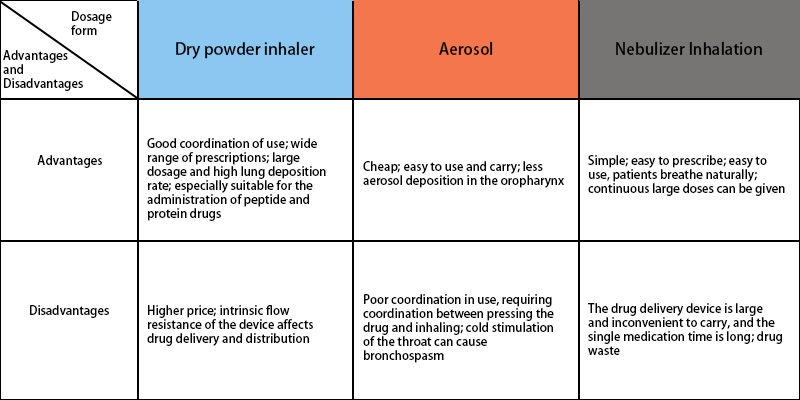What is aerosol nebulization?
Aerosol nebulization refers to the use of a nebulizer inhalation device to form a fine mist of drug solution, which enters the airways and lungs directly with natural breathing. The drug is absorbed through the mucous membrane and exerts its effect locally. Inhaled drugs reach the target organs directly, take effect quickly and have good efficacy; and the drugs act locally, reducing systemic side effects.
Inhaled drugs play important role in the whole course treatment of COPD, asthma and other diseases. Portable dry powder inhalers and aerosols require patients to have a certain suction power or hand-mouth coordination. However, some elderly patients cannot use them skillfully. At this time, the nebulizer inhalation device can perfectly achieve this function.
The incidence of reqpiratory tract infections in children is much higher than in adults. The median number of viral respiratory infections in children is 5 times per year, and 10% of children have more than 10 respiratory viral infections per year. The incidence of asthma in children is also more than twice that of adults.
Since aerosol nebulization is convenient to use and easy to cooperate with, it is also a treatment method often recommended by pediatricians. Parents can nebulize their children at home, which can save time in going to and from the hospital and avoid cross-infection in the hospital that may aggravate the condition.
Therefore, aerosol nebulization can be said to be suitable for people of all ages, young, middle-aged and old, and a must-have remedy for home and travel.
What are the categories of aerosol nebulization?
Accrording to different principles, atomization devices are divided into three types: jet atomizer, ultrasonic atomizer, and vibrating mesh atomizer.
The most common jet nebulizer uses the Venturi jet principle. The gas moves at high speed through a narrow opening and then suddenly decompresses, creating a negative pressure locally. The siphon effect caused by the negative pressure draws the liquid medicine in the container out, and when the liquid medicine encounters the high-pressure airflow, it is broken into countless drug particles.
The common flow rate in clinical practice is 4-12L/min gas driven. The flow rate of the gas source affects the size of the aerosol particles and the amount of aerosol per unit time. Higher flow rates produce more aerosol and smaller aerosol particles.
Compressed air nebulizers are usually the first choice for home nebulization. Oxygen concentrators with an oxygen flow rate greater than 5L can also be used as an air source to support aerosol nebulization. It should be noted that for some patients who are prone to CO2 retention(such as COPD with respiratory failure), it is recommended to use a compressed air nebulizer. This is because high-flow oxygen as a gas source will rapidly increase PaO2 while also aggravating CO2 retention.
What is the purpose of aerosol nebulization?
- Humidified airway
- Control reapiratory infections
- Improve ventilation function
- Relieve bronchospasm
How to atomize correctly?
Before aerosol nebulization:
- Aerosol nebulization preparations should be used immediately after opening the bottle
- Some medicines cannot be mixed in the same container and should be used strictly addording to the doctor’s instructions
- Do not eat 1 hour before nebulization inhalation treatment, clean oral secretions and food residues to prevent vomiting caused by airflow stimulation during nebulization
During aerosol nebulization
- Prepare the drug solution and put it into the nebulizer inhaler. If oxygen is used to drive the nebulization, the oxygen flow rate should be adjusted to 6-8L/min. Observe the nebulization situation and be careful not to splash the drug solution into the eyes
- Adopt a comfortable sitting or semi-recumbent position, and take deep breaths by inhaling through the mouth and exhaling through the nose to ensure that the medicine can fully reach the bronchi and lungs
- Pay close attention to potential adverse frug reactions in patients undergoing nebulized inhalation therapy
- If you have acute and frequent coughing and worsening wheezing, if it is cause by too fast or too strong atomization, you should slow down the aerosol nebulization speed
After aeosol nebulization
- Wash your face immediately, or wipe the mist droplets below the mouth and nose with a wet towel to prevent the residual mist droplets from irritating the skin of the mouth and nose and causing skin allergies or damage
- Infants and young children have thin facial skin and rich blood vessels, so redidual medicine is more easily absorbed and needs to be washed promptly
- Young children can wipe their mouths with cotton balls dipped in water and then give them an appropriate amount of water, especially after using hormone drugs, to reduce hormone deposition in the oropharynx and reduce the occurrence of adverse reactions such as fungal infections
- Turning over and patting the back in time can help remove the sputum adhering to the trachea and bronchial walls and keep the airway open
How to clean the atomizer?
Masks are for one person only, and the nebulizer mask or mouthpiece should be disinfected and replaced regularly to minmize contamination(nebulizer masks are generally replaced after 15 days or 30 uses. Long-term use will cause abnormal drug output and affect the treatment effect).
Especially after nebulization treatment at home, the nebulizer needs to be removed and thoroughly cleaned with running water; the medicine storage tank and the connecting pipe need to be separated, soaked in 75% alcohol or chlorine-containing disinfectant for 30 minutes, then taken out and rinsed with running water, and dried thoroughly for use.
Post time: May-23-2025

